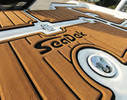
Sea Decking on Boats: Exploring the Pros and Cons of this Popular Marine Flooring Option
, by Safe Water Team, 3 min reading time

, by Safe Water Team, 3 min reading time
Sea decking, also known as marine or boat decking, has become increasingly popular among boat owners as a versatile alternative to traditional flooring materials. Made from high-quality, closed-cell EVA foam, sea decking offers a range of benefits, but like any marine product, it also has its drawbacks. In this article, we'll delve into the pros and cons of sea decking to help you make an informed decision about whether it's the right choice for your boat.
Comfort: Sea decking provides a soft, cushioned surface underfoot, making it more comfortable to stand and walk on for extended periods. This is especially beneficial for boat owners who spend long hours on the water, whether fishing, cruising, or entertaining guests.
Traction: Sea decking offers excellent traction, even when wet. Its textured surface helps to prevent slips and falls, providing added safety for passengers and crew, particularly in rough seas or adverse weather conditions.
Durability: Marine-grade sea decking is highly durable and resistant to wear, tear, and fading. It can withstand exposure to saltwater, UV rays, and harsh marine environments, making it a long-lasting flooring solution for boats of all types.
Easy Maintenance: Sea decking is easy to clean and maintain, requiring only periodic washing with soap and water to remove dirt, salt, and debris. Unlike traditional carpeting or wood flooring, sea decking does not require sanding, staining, or refinishing, saving time and effort in maintenance.
Customization: Sea decking is available in a wide range of colors, textures, and patterns, allowing boat owners to customize their flooring to suit their personal style and preferences. Custom logos, graphics, and designs can also be incorporated into sea decking for a unique and personalized look.
Cost: Sea decking can be more expensive upfront than other flooring options, such as carpeting or vinyl. However, many boat owners consider it a worthwhile investment due to its durability, longevity, and aesthetic appeal.
Heat Retention: Sea decking can absorb and retain heat when exposed to direct sunlight, especially in darker colors. This can make the surface hot to the touch, potentially uncomfortable for bare feet. However, some manufacturers offer lighter-colored options or incorporate heat-reflective properties to mitigate this issue.
Installation Complexity: While sea decking can be installed as a DIY project, achieving professional-looking results may require skill and precision. Improper installation can lead to gaps, wrinkles, or adhesive failure, compromising the integrity and appearance of the flooring.
Slippery When Wet: While sea decking provides excellent traction in most conditions, it can become slippery when wet with certain substances, such as oil, grease, or algae. Regular cleaning and maintenance are essential to prevent buildup and maintain optimal traction.
Potential for Discoloration: Over time, sea decking may experience discoloration or fading due to prolonged exposure to UV rays, particularly in darker colors. Choosing lighter-colored sea decking or applying UV-resistant coatings can help minimize this issue.
Sea decking offers numerous benefits as a versatile and durable flooring option for boats, providing comfort, safety, and aesthetic appeal. However, it's essential to weigh these advantages against potential drawbacks such as cost, heat retention, and installation complexity. By considering your specific needs, preferences, and budget, you can determine whether sea decking is the right choice for enhancing the functionality and appearance of your boat's interior and exterior spaces.